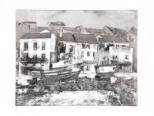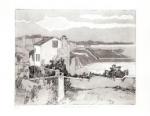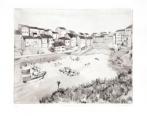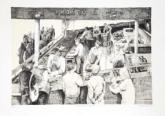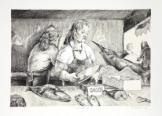Gallery
Phil Kreveld Etchings
Asturian Adventure
Etchings by Phil Kreveld
Asturias is an autonomous region of Spain. It borders the Atlantic and was historically a bastion against the Moors. Its capital is Oviedo and some etchings are scenes in that city. Many of the etchings came about during my stay in the fishing village of Tapia de Casariego where my friends Teresa and John Ford had invited me to stay with them over a few weeks of the Northern European summer--and to remain there for as long as I liked. Tapia is a quiet place The fishermen go about their daily routines, mending nets, caulking and repairing deck gear, the children in the village school cry out gaily in their games during recess, the old men sit in the plaza soaking in the sun’s warmth, the women sing while doing their domestic chores, and the seagulls’ shrill cries fill the air--the invigorating salt-laden air of the North-Atlantic. In the evening, the fishermen gather at the Cofradia de Pescadores, their dark, weathered faces illuminated by the red glow of their cigarettes--and I would make my last paseo along the harbour and rocky shores of Tapia, the evening breeze drying the moisture in my eyes as I witnessed the dying day, displaying a diaphanous brilliance finally expiring in a blaze of colour. I grew to love that small dot on the map--and only need to close my eyes to feel the warmth of the sun on my face standing on ‘el balcon’ and to see the small harbour below me.
Some words on etching
Those unfamiliar with the process might confuse it with prints one buys at framers. The only thing in common with commercially produced prints is that both are available in multiple copies. But etchings are made with perhaps edition numbers as high as 50 (or more if the theme is popular and the artist of note) whereas commercial prints are produced in thousands. The process of making the two versions are chalk and cheese. Etching prints are made in small numbers, on manual presses; commercial prints on 7-colour, or more, automatic presses. Making etching prints is very labour intensive and requires the print maker to be artistically sensitive to the desired outcome of the artist. Not so with commercial prints although the initial adjustment of the press to the approved colour-proof is also a very skilful task.
The etching process consists of transferring an image onto a metal plate; copper or zinc. The metal plate is covered with a thin layer of ground, a kind of varnish consisting of beeswax, asphaltum, organic solvents, etc. The image is made by scratching into the ground exposing the metal and then exposing the plate to a mordant which in the case of the copper plate etchings on show, is ferric chloride. The mordant makes fine groves into the metal which will hold ink. Once the plate has been sufficiently ‘bitten’, the ground is removed and the plate is ready for printing.
The printing process consists of covering the plate with an etching ink, usually oil-based, and then wiping the plate with various materials, chiefly tarlatan (a type of open weave cloth), old newspaper, and the palm of the hand. The wiping process is critical in order to ‘bring the image to life’. The ink is retained in the etched lines. An impression is then made onto moistened paper by passing the inked plate lying on a platen, face up, the moistened paper on top in turned covered by blankets, beneath a hand-cranked steel roller. The paper which is specially suited to the process and very expensive, is peeled off the plate and dried under weights. The whole process is repeated for each fresh impression.
Some words on lithography
Unlike etching, lithography (drawing on stone) is a straightforward process. The designs are rendered with a fatty pencil or brushed on with a fatty ink onto a flat-surface stone tablet, and as such resembles drawing on paper. The printing is a much more complicated process than is the case for etchings. The principle is straightforward, but in order to produce a quality print, many steps are involved prior to the actual printing step. Having completed the drawing, and a number of so-called 'etching' steps (note: it's a term that doesn't resemble what is involved in the metal etching process described above), the stone is moistened with water, and after inking the stone, the ink adheres to the areas that repel water (the drawing) but not to the areas where there is no drawing. The design is thus transferred to a sheet of paper placed on the stone, using pressure (the stone and the paper, residing on a moving platen, is passed underneath a scraper bar).
Phil Kreveld, painter and printmaker.
Enquiries and sales, please call 0418 530 781
Unframed etchings and lithographs are $200. Each sale provides $100 for the community work of Carlton Rotary Club
Back to Gallery
